Paper title:N–doped carbon anchored CoS2/MoS2 nanosheets as efficient electrocatalysts for overall water splitting(nitrogen doped CoS2/MoS2Nanoplates as efficient electrocatalysts for total water cracking)
Journals:Frontiers of Optoelectronics
Authors: xing Wei Zhou, Wei Zhang, Zun Hao Zhang, Zizhun Wang, Xu Zou, Dabing Li, Wei Tao Zheng.
Publication date: 15 Sep 2022
DOI:10.1007/s12200-022-00034-3
Wechat link:Click here to read the WeChat article.
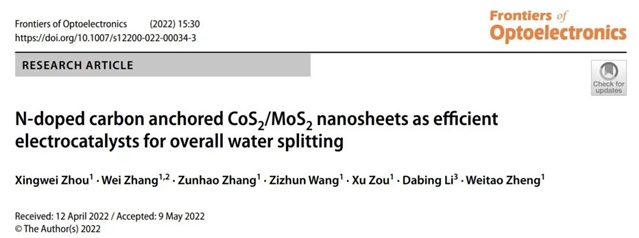
First author: Zhou Xingwei
Correspondents: Zhang Wei, Zou Xu
Communication unit: Jilin University
Research background
Hydrogen energy is a clean, carbon-free, flexible and efficient secondary energy with various forms of utilization. Vigorously developing the hydrogen energy industry and accelerating the clean transformation of energy structure are the ideal ways to achieve the "double carbon goal". Using renewable energy power supply system coupled with electrolytic water technology to produce decarbonized "green hydrogen" is the strategic direction of hydrogen energy industry development in the future. Electrolytic water reaction is a high energy consumption process, which is not easy to occur in thermodynamics and kinetics. The key to improve the overall efficiency of electrolytic water reaction lies in the research and development of efficient catalytic materials.
Introduction to the article
In recent years, a large number of catalytic materials without noble metals have been widely studied, but these materials only show good electrocatalytic activity in hydrogen evolution reaction (HER) or oxygen evolution reaction (OER), and there are few studies on bifunctional electrocatalysts that are effective for both HER and OER.
Recently, Zhou Xingwei, a research team of Professor Zheng Weitao of Jilin University, and others prepared a nitrogen-doped CoS on carbon fiber cloth (CC) by hydrothermal-annealing-hydrothermal method.2And MoS2Nanoplate-coupled bifunctional electrocatalyst (MOS/COS/CC), the prepared MOS/COS/CC catalyst has rich active sites and stable structure, and shows excellent HER and OER performance in alkaline electrolyte. Related work toN–doped carbon anchored CoS2/MoS2 nanosheets as efficient electrocatalysts for overall water splitting The title was published on July 18, 2022.Frontiers of Optoelectronics In the journal.
Graphic reading guide
Innovation 1: Simple hydrothermal-annealing-hydrothermal method to prepare different MoS.2Content of MOS/COS/CC catalyst
Growth of nitrogen-doped CoS on carbon fiber cloth by hydrothermal-annealing-hydrothermal method.2/MoS2The schematic diagram of the synthesis process of nanosheet catalytic materials is shown in Figure 1, and the scanning electron microscope (SEM) photos of MOS/COS/CC at different synthesis times are shown in Figure 2. By controlling the hydrothermal reaction time in the second step, MoS with different scales can be obtained.2With CoS2Composite catalytic materials. MoS2Growth time significantly affects the surface area of the catalyst (Figure 2). With the increase of hydrothermal time, MoS deposited on the substrate2The number of nanosheets increased gradually, and cracks appeared on the catalyst surface when the deposition time was too long.
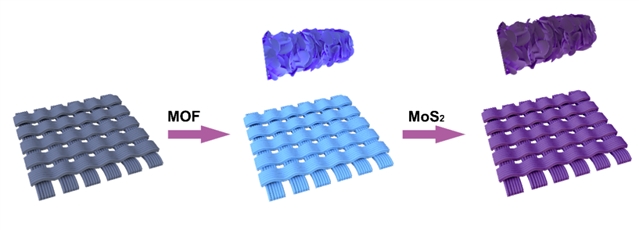
Fig. 1 synthesis diagram of mos/cos/cc
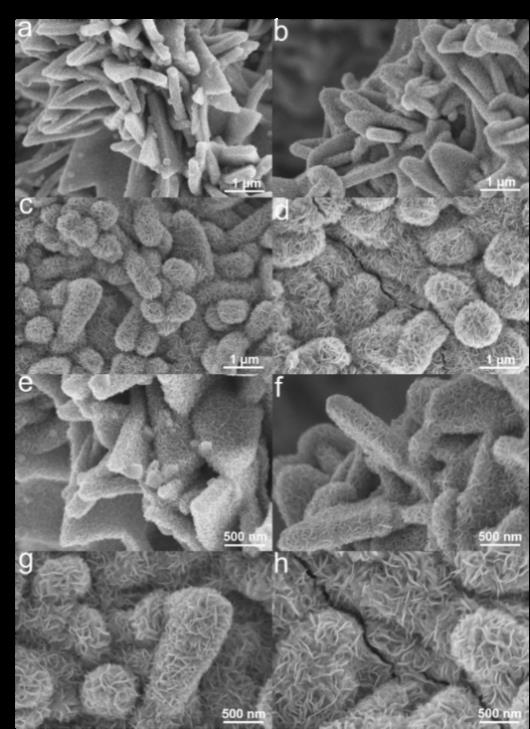
Fig. 2 SEM photos of MOS/COS/CC at different synthesis times: (a,e)2h,(b,f)4h,(c,g)6h,(d,h)8h.
X-ray diffraction (XRD) pattern of MoS/COS/CC proves MOS.2With CoS2Generation of, in which MoS2It is a hexagonal 2H phase (Figure 3). The 0.65 nm crystal plane spacing corresponds to hexagonal MoS in high resolution transmission electron microscope (HRTEM) photos.2 (002) crystal plane, 0.245 nm corresponds to CoS.2 (210) crystal plane, which confirmed the CoS.2/MoS2The existence of heterostructure. TEM-EDX photos show that Mo, S, Co and N are uniformly distributed in MOS/COS/CC (Figure 4).
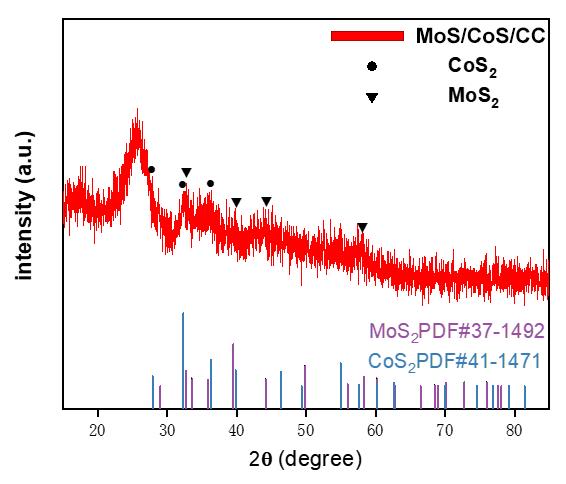
Fig. 3 XRD spectrum of mos/cos/cc
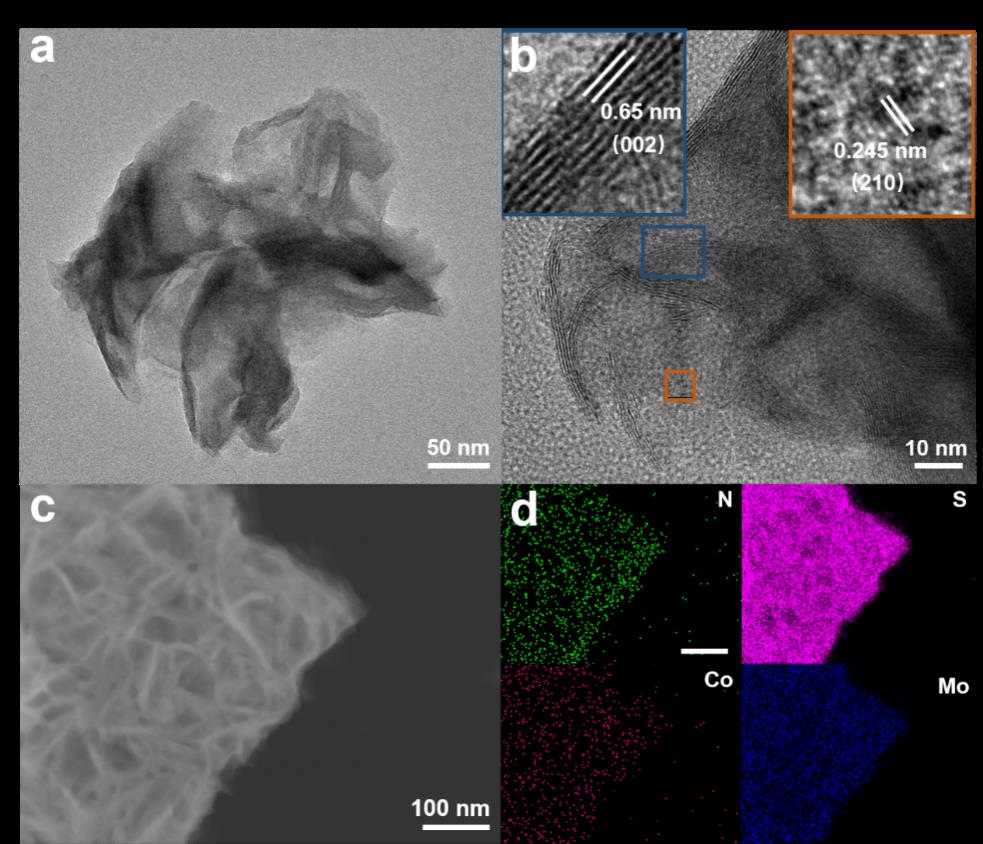
Figs. 4 (a) and 4 (b) are TEM photos and HRTEM photos of MOS/COS/CC, and (c) and (d) are elemental distribution maps of MOS/COS/CC.
Innovation 2: MOS/COS/CC catalyst shows excellent HER and OER performance.
The comparison of HER and OER performance of MOS/COS/CC catalyst with commercial catalyst is shown in fig. 5. We compared different MoS in 1.0 mol/L KOH solution.2Growth time of MOS/COS/CC catalyst and commercial RuO2OER performance of catalyst. The linear voltammetric scanning curve (LSV) shows that MOS/COS/CC-6H shows the lowest overpotential (197 mV), which is lower than that of commercial RuO.2Catalyst. In addition, the MOS/COS/CC-6H catalyst has the lowest Tafel slope (64 mV dec-1), which indicates that the material has fast reaction kinetics, which is beneficial to the catalytic reaction. In addition, we compared different MoS in 1.0 mol/L KOH.2HER performance of MOS/COS/CC catalyst with growth time and commercial Pt/C catalyst. It is not difficult to find that MOS/COS/CC-6H also shows excellent HER performance. MOS/COS/CC-6H also has advantages over commercial RuO.2The stability of. The excellent catalytic activity and stability of MoS/COS/CC-6H benefit from MOS.2With CoS2The multi-stage structure of the material exposes more catalytic active sites, and the three-dimensional self-supporting structure grown in situ on CC shows excellent structural stability.
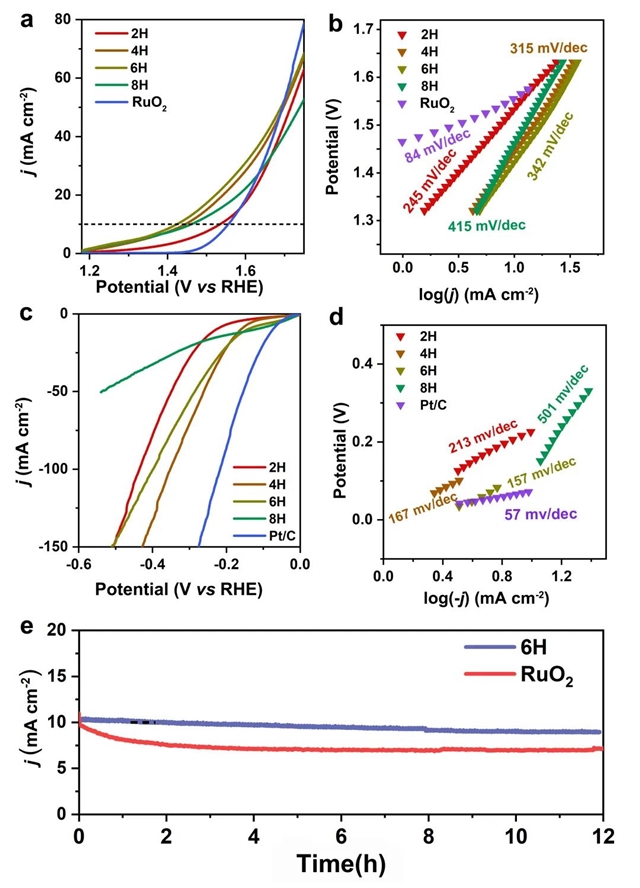
Fig. 5 different MoS2Growth time of MOS/COS/CC catalyst and commercial RuO2And the results of OER and HER performance tests of Pt/C catalyst: (a) linear voltammogram of oer test, (b) Tafel curve of oer test, (c) linear voltammogram of her, (d) Tafel curve of her test and (e) stability test results.
Summary and outlook
We developed a simple and effective method to construct heterostructure, and the prepared MOS/COS/CC catalyst showed excellent OER and HER activity in alkaline solution. Its excellent performance is attributed to rich active sites and stable morphology and structure. The synthesis method proposed by us provides an effective strategy for developing multi-level structure nanocomposites.
Introduction of communication author
Zhang WeiDirector of Electron Microscope Center of Jilin University, Tang Aoqing scholar-leading professor and doctoral supervisor. He is also the vice chairman of the Surface and Interface Physics Association of the Chinese Physical Society and the Jilin Electron Microscope Society. In 2004, he received a Ph.D. degree from China Institute of Metals, and successively engaged in scientific research in Japanese Institute of Materials, Samsung Institute of Comprehensive Technology, Fritz-Haber Institute of Germany, and data transfer unit and Spanish Energy Cooperation Research Center. He is in charge of general projects of NSFC, sub-projects of key projects and international cooperation projects of Jilin Science and Technology Department. His main research interests are surface/interface chemistry of catalysis and energy materials and electron microscopic analysis of advanced materials.
Zou Xu, Ph.D. graduated from College of Chemistry, Jilin University, under the supervision of Professor Li Guodong. In 2020, he was selected into the "Ding Xin Scholar" support program of Jilin University to carry out postdoctoral work, and his tutor was Professor Zheng Weitao. Up to now, the first (including one)/correspondent has published 8 research papers in Adv. Mater., J. Energy Chem, Angew. Chem. Int. Ed., Adv. Energy Mater. and other important academic journals. Among them, Adv. Mater was cited for more than 340 times and was selected as the "highly cited paper" of ESI. In addition, we applied for two invention patents in China. He presided over 3 scientific research projects, such as youth projects and doctoral programs (first-class).
abstract
The oriented two-dimensional porous nitrogen-doped carbon embedded with CoS2 and MoS2 nanosheets is a highly efficient bifunctional electrocatalyst. The hierarchical structure ensures fast mass transfer capacity in improving the electroc atalytic activity. And the greatly increased specific surface area is beneficial to expose more electrocatalytically active atoms. For oxygen evolution reaction (OER) and hydrogen evolution reaction (HER) tests in 1 mol/L KOH solution, only 194 and 140 mV overpotential are required to achieve a current density of 10 mA/cm2, respectively. Our research provides an effective strategy for synergizing the individual components in nanostructures for a wide range of electrocatalytic reactions.
Brief introduction of periodicals
Frontiers of Optoelectronics (FOE) is one of the English academic periodicals of Frontiers series, which is published by the Ministry of Education, Higher Education Press, and published overseas by Springer Publishing Company. Gong Qihuang from Peking University and Professor Zhang Xinliang from Huazhong University of Science and Technology are co-editors.
Its purpose is to introduce the latest research results and frontier progress in the international optoelectronics field, and strive to become an important information platform for researchers in this field to conduct rapid academic exchanges with their counterparts at home and abroad. The journal is co-sponsored by Higher Education Press, Huazhong University of Science and Technology and chinese optical society, and the organizer is Wuhan Optoelectronic National Research Center. FOE periodicals have been collected by Emerging Sources Citation Index (Esci), EI Compendex, Scopus, Inspec, Google Scholar, CsA, Chinese Science Citation Database (CSCD), OCLC, Scimago, Summer by Proquest, etc. In 2019, it was selected as the echelon periodical project of China Science and Technology Journals Excellence Action Plan.
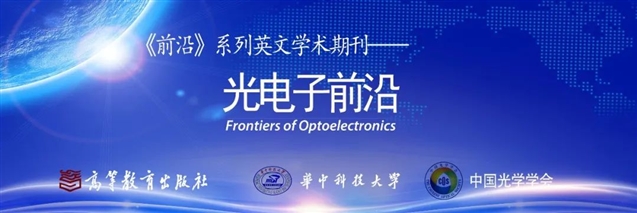
Frontier series of English academic journals
Frontiers, a series of English academic journals sponsored by the Ministry of Education and Higher Education Press, was officially founded in 2006 and distributed to the whole world in online and print editions. The series of periodicals includes four topics: basic science, life science, engineering technology and humanities and social sciences. It is the most extensive English academic periodical group in China, of which 13 are included by SCI, and others are also included by A&HCI, Ei, MEDLINE or international authoritative retrieval systems of corresponding disciplines, which has certain international academic influence. The series of periodicals adopt online priority publishing method to ensure that articles are published at the fastest speed.
China Academic Frontier Journal Network
http://journal.hep.com.cn

关于作者